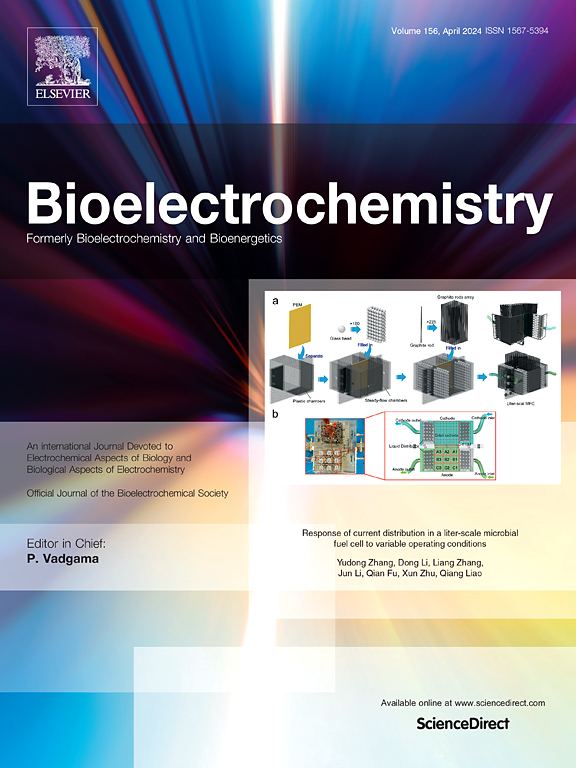An efficient ECL aptasensor based on resonance energy transfer between NCDs@Ag3PO4 and Cu-doped Cu: Eu MOF for the detection of diethylstilbestrol
IF 4.8
2区 化学
Q1 BIOCHEMISTRY & MOLECULAR BIOLOGY
引用次数: 0
Abstract
As a synthetic estrogen, diethylstilbestrol (DES) residues in water pose a threat to human health. In this work, a novel electrochemiluminescence resonance energy transfer (ECL-RET) aptamer sensor based on NCDs@Ag3PO4 as a resonance energy transfer donor and Cu2+ doped Eu MOF (Cu: Eu MOF) as an efficient resonance energy transfer acceptor for the detection of diethylstilbestrol (DES) was proposed for the first time. The aptamer sensor uses Ag3PO4 nanoparticles loaded with nitrogen-doped carbon quantum dots (NCDs) as the ECL emitter, which improves the electron transfer efficiency of the sensor and promotes the generation of SO4·- radicals, thereby improving the luminescence intensity and stability of the ECL sensor. The energy acceptor Cu: Eu MOF binds to the apt on NCDs@Ag3PO4 by complementary base pairing through complementary DNA (cDNA). When DES is present in the sample, DES competes with the energy acceptor. The stronger interaction between DES and apt leads to the shedding of Cu: Eu MOF-cDNA from the electrode and the recovery of ECL signal. Based on this, under optimal conditions, the linear range of the sensor for detecting DES is 1.0 × 10−13–1.0 × 10−6 M, and the detection limit is 7.4 × 10−14 M (S/N = 3). The developed aptasensor showed excellent recognition ability for residual DES in actual water samples. The sensor has superior measurement ability and potential application value in the field of environmental water quality monitoring.

基于NCDs@Ag3PO4和掺杂铜的Cu.Eu MOF之间共振能量转移的高效ECL诱导传感器,用于检测己烯雌酚:Eu MOF 的共振能量转移,用于检测己烯雌酚
己烯雌酚(DES)是一种合成雌激素,其在水中的残留对人体健康构成威胁。本文首次提出了一种新型的电化学发光共振能量转移(ECL-RET)适体传感器,该传感器以NCDs@Ag3PO4为共振能量转移供体,以Cu2+掺杂的Eu MOF (Cu: Eu MOF)为高效的共振能量转移受体,用于检测己烯雌酚(DES)。适体传感器采用负载氮掺杂碳量子点(NCDs)的Ag3PO4纳米颗粒作为ECL发射器,提高了传感器的电子传递效率,促进了SO4·-自由基的生成,从而提高了ECL传感器的发光强度和稳定性。能量受体Cu: Eu MOF通过互补DNA (cDNA)的互补碱基配对与NCDs@Ag3PO4上的apt结合。当样品中存在DES时,DES与能量受体竞争。DES与apt之间更强的相互作用导致Cu: Eu MOF-cDNA从电极上脱落,ECL信号恢复。在此基础上,在最佳条件下,该传感器检测DES的线性范围为1.0 × 10−13 ~ 1.0 × 10−6 M,检出限为7.4 × 10−14 M (S/N = 3)。所研制的适体传感器对实际水样中残留DES具有良好的识别能力。该传感器在环境水质监测领域具有优越的测量能力和潜在的应用价值。
本文章由计算机程序翻译,如有差异,请以英文原文为准。
求助全文
约1分钟内获得全文
求助全文
来源期刊

Bioelectrochemistry
生物-电化学
CiteScore
9.10
自引率
6.00%
发文量
238
审稿时长
38 days
期刊介绍:
An International Journal Devoted to Electrochemical Aspects of Biology and Biological Aspects of Electrochemistry
Bioelectrochemistry is an international journal devoted to electrochemical principles in biology and biological aspects of electrochemistry. It publishes experimental and theoretical papers dealing with the electrochemical aspects of:
• Electrified interfaces (electric double layers, adsorption, electron transfer, protein electrochemistry, basic principles of biosensors, biosensor interfaces and bio-nanosensor design and construction.
• Electric and magnetic field effects (field-dependent processes, field interactions with molecules, intramolecular field effects, sensory systems for electric and magnetic fields, molecular and cellular mechanisms)
• Bioenergetics and signal transduction (energy conversion, photosynthetic and visual membranes)
• Biomembranes and model membranes (thermodynamics and mechanics, membrane transport, electroporation, fusion and insertion)
• Electrochemical applications in medicine and biotechnology (drug delivery and gene transfer to cells and tissues, iontophoresis, skin electroporation, injury and repair).
• Organization and use of arrays in-vitro and in-vivo, including as part of feedback control.
• Electrochemical interrogation of biofilms as generated by microorganisms and tissue reaction associated with medical implants.
 求助内容:
求助内容: 应助结果提醒方式:
应助结果提醒方式:


